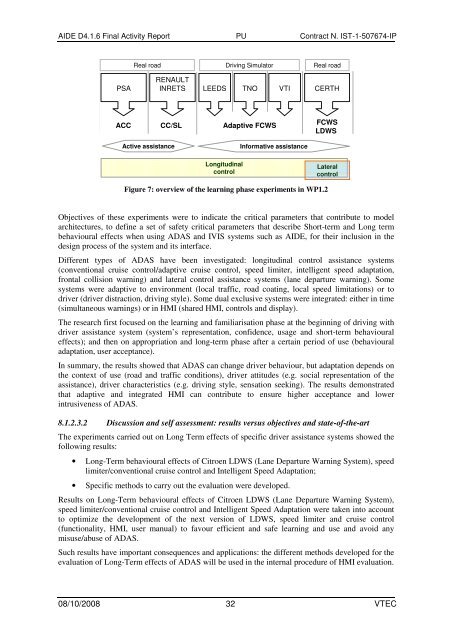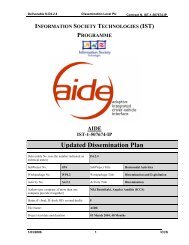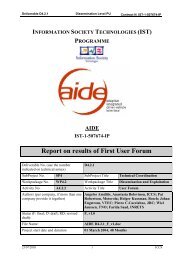download deliverable - AIDE
download deliverable - AIDE
download deliverable - AIDE
Create successful ePaper yourself
Turn your PDF publications into a flip-book with our unique Google optimized e-Paper software.
<strong>AIDE</strong> D4.1.6 Final Activity Report PU Contract N. IST-1-507674-IP<br />
PSA<br />
Real road Driving Simulator<br />
Real road<br />
RENAULT<br />
INRETS LEEDS TNO VTI CERTH<br />
ACC CC/SL Adaptive FCWS<br />
Active assistance Informative assistance<br />
Longitudinal<br />
control<br />
FCWS<br />
LDWS<br />
Lateral<br />
control<br />
Figure 7: overview of the learning phase experiments in WP1.2<br />
Objectives of these experiments were to indicate the critical parameters that contribute to model<br />
architectures, to define a set of safety critical parameters that describe Short-term and Long term<br />
behavioural effects when using ADAS and IVIS systems such as <strong>AIDE</strong>, for their inclusion in the<br />
design process of the system and its interface.<br />
Different types of ADAS have been investigated: longitudinal control assistance systems<br />
(conventional cruise control/adaptive cruise control, speed limiter, intelligent speed adaptation,<br />
frontal collision warning) and lateral control assistance systems (lane departure warning). Some<br />
systems were adaptive to environment (local traffic, road coating, local speed limitations) or to<br />
driver (driver distraction, driving style). Some dual exclusive systems were integrated: either in time<br />
(simultaneous warnings) or in HMI (shared HMI, controls and display).<br />
The research first focused on the learning and familiarisation phase at the beginning of driving with<br />
driver assistance system (system’s representation, confidence, usage and short-term behavioural<br />
effects); and then on appropriation and long-term phase after a certain period of use (behavioural<br />
adaptation, user acceptance).<br />
In summary, the results showed that ADAS can change driver behaviour, but adaptation depends on<br />
the context of use (road and traffic conditions), driver attitudes (e.g. social representation of the<br />
assistance), driver characteristics (e.g. driving style, sensation seeking). The results demonstrated<br />
that adaptive and integrated HMI can contribute to ensure higher acceptance and lower<br />
intrusiveness of ADAS.<br />
8.1.2.3.2 Discussion and self assessment: results versus objectives and state-of-the-art<br />
The experiments carried out on Long Term effects of specific driver assistance systems showed the<br />
following results:<br />
• Long-Term behavioural effects of Citroen LDWS (Lane Departure Warning System), speed<br />
limiter/conventional cruise control and Intelligent Speed Adaptation;<br />
• Specific methods to carry out the evaluation were developed.<br />
Results on Long-Term behavioural effects of Citroen LDWS (Lane Departure Warning System),<br />
speed limiter/conventional cruise control and Intelligent Speed Adaptation were taken into account<br />
to optimize the development of the next version of LDWS, speed limiter and cruise control<br />
(functionality, HMI, user manual) to favour efficient and safe learning and use and avoid any<br />
misuse/abuse of ADAS.<br />
Such results have important consequences and applications: the different methods developed for the<br />
evaluation of Long-Term effects of ADAS will be used in the internal procedure of HMI evaluation.<br />
08/10/2008 32 VTEC







